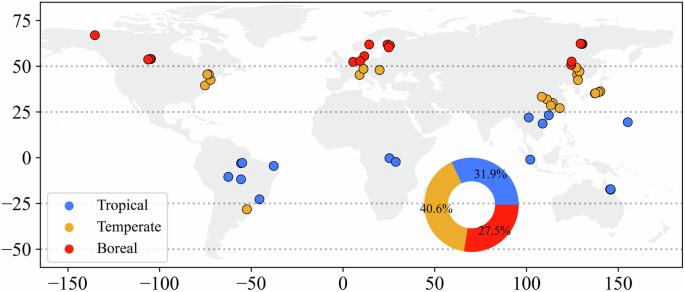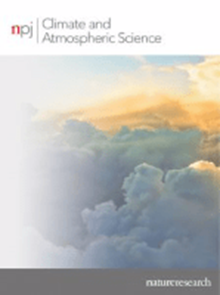森林生态系统氧化亚氮排放的全球纬度模式与水文气候有关
IF 8.5
1区 地球科学
Q1 METEOROLOGY & ATMOSPHERIC SCIENCES
引用次数: 0
摘要
一氧化二氮(N2O)排放是一个严重的全球性问题,大量证据表明,水文气候过程在很大程度上导致了这些排放。森林占全球陆地面积的三分之一,是水循环的关键,影响着水文气候过程,而水文气候过程因气候、纬度和森林类型而异。水文气候在调节全球森林一氧化二氮排放中的作用在很大程度上仍不为人所知。我们的全球分析表明,水文气候因素主导着森林一氧化二氮通量的纬度梯度,而森林一氧化二氮通量则随纬度的增加而减少。热带森林的 N2O 通量最高,其次是温带森林和北方森林。水文气候因素占 N2O 通量的 78.2%,土壤因素占 21.8%。我们的研究结果迫切要求今后开展研究,探讨一氧化二氮通量与辐射、蒸散和蒸汽压力不足等水文气候因素之间的关系。总之,这些研究结果凸显了水文气候对一氧化二氮排放的重要影响,并建议将这些因素纳入预测模型,以提高预测的准确性。本文章由计算机程序翻译,如有差异,请以英文原文为准。

Global latitudinal patterns in forest ecosystem nitrous oxide emissions are related to hydroclimate
Nitrous oxide (N2O) emissions are a serious global issue, with substantial evidence indicating that hydroclimate processes significantly contribute to these emissions. Forests, covering one-third of global land, are key in the water cycle and influence hydroclimate processes, which vary with climate, latitude, and forest types. The role of hydroclimate in regulating global forest N2O emission remains largely unknown. Our global analysis shows that hydroclimate factors dominate the latitudinal gradient of forest N2O fluxes, which decrease with latitude. N2O fluxes are highest in tropical forests, followed by temperate and boreal forests. Hydroclimate factors contribute 78.2% to N2O fluxes, while soil factors contribute 21.8%. Our results urgently call for future studies to investigate the relationship between N2O flux and hydroclimate factors like radiation, evapotranspiration, and vapor pressure deficits. Collectively, these findings highlight hydroclimate significant impact on N2O emissions and suggest incorporating these factors into predictive models for greater accuracy.
求助全文
通过发布文献求助,成功后即可免费获取论文全文。
去求助
来源期刊

npj Climate and Atmospheric Science
Earth and Planetary Sciences-Atmospheric Science
CiteScore
8.80
自引率
3.30%
发文量
87
审稿时长
21 weeks
期刊介绍:
npj Climate and Atmospheric Science is an open-access journal encompassing the relevant physical, chemical, and biological aspects of atmospheric and climate science. The journal places particular emphasis on regional studies that unveil new insights into specific localities, including examinations of local atmospheric composition, such as aerosols.
The range of topics covered by the journal includes climate dynamics, climate variability, weather and climate prediction, climate change, ocean dynamics, weather extremes, air pollution, atmospheric chemistry (including aerosols), the hydrological cycle, and atmosphere–ocean and atmosphere–land interactions. The journal welcomes studies employing a diverse array of methods, including numerical and statistical modeling, the development and application of in situ observational techniques, remote sensing, and the development or evaluation of new reanalyses.
 求助内容:
求助内容: 应助结果提醒方式:
应助结果提醒方式:


